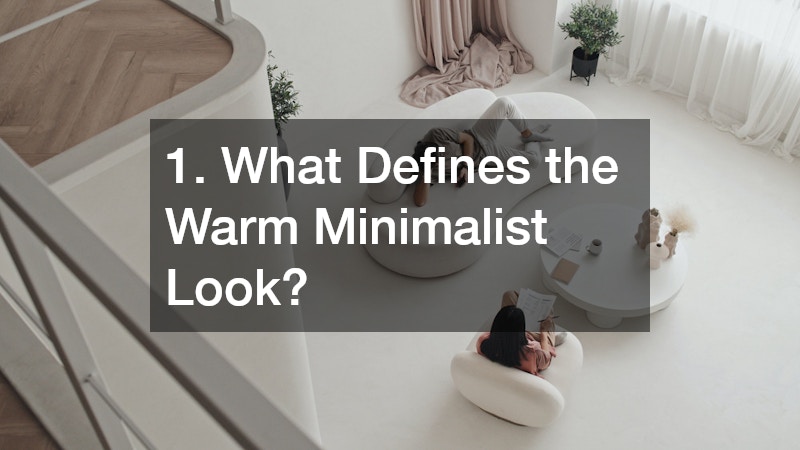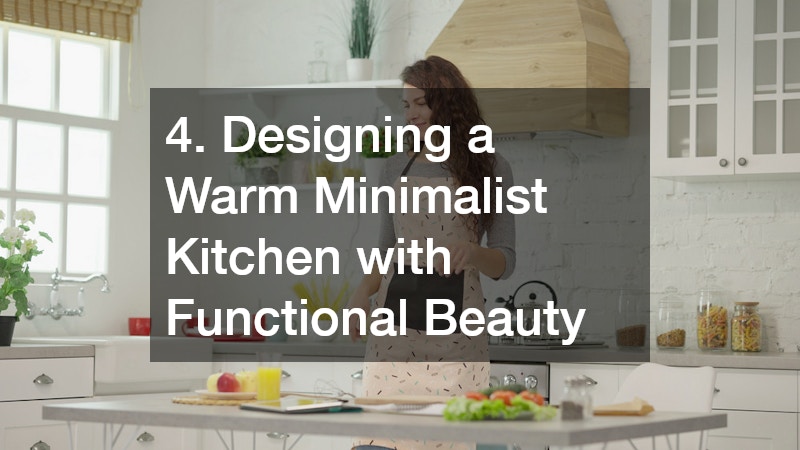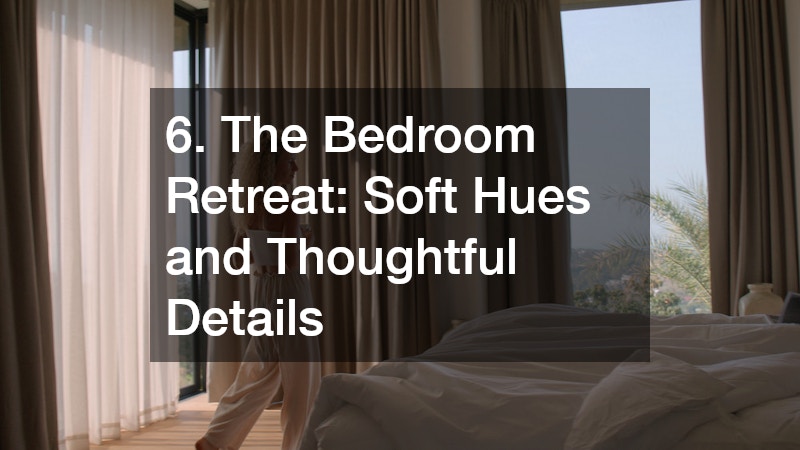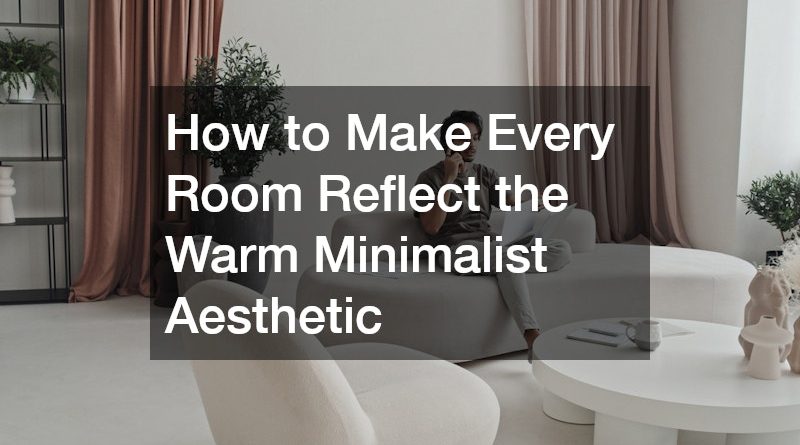How to Make Every Room Reflect the Warm Minimalist Aesthetic
Warm minimalism has become the design world’s favorite balance between simplicity and comfort. It’s a style that blends the calm, clutter-free look of minimalism with the soft, inviting feel of cozy interiors. Think natural light, organic textures, neutral palettes, and pieces that feel personal yet purposeful.
This aesthetic proves that “less is more” doesn’t have to mean cold or impersonal—it’s about warmth, harmony, and thoughtful design choices that make every room feel lived in, not staged. Let’s explore how you can bring this look to every corner of your home.
1. What Defines the Warm Minimalist Look?

At its core, warm minimalism is about creating peace through restraint—but not sterility. It’s a design philosophy that celebrates open spaces, natural materials, and comfort-driven details. Unlike cold, ultra-modern styles, this approach invites softness and human touch into every corner of your home.
Key features include:
-
A neutral color palette with warm undertones (think beige, taupe, cream, and muted clay tones).
-
A mix of clean-lined furniture and soft, tactile fabrics.
-
Natural materials like wood, linen, wool, and stone.
-
Intentional decor—each object has meaning or function.
Many interior designers view warm minimalism as the next evolution of simplicity, where comfort meets intentional living. It’s also one of today’s most enduring minimalism trends, blending Scandinavian restraint with the cozy sensibility of organic modern design.
Unlike stark minimalism, which can sometimes feel empty or overly modern, warm minimalism adds texture, warmth, and personality. The result is a home that feels calm but full of life—a space that nurtures rather than overwhelms.
2. Creating a Calming Entryway That Sets the Tone
Your entryway is the first impression of your home—and the perfect place to introduce warm minimalism. This is where the tone for your entire space begins, so every element should feel balanced, natural, and intentional.
Start with a neutral foundation. Light walls and simple flooring help reflect natural light and open up the space. If you’re updating flooring, consider warm-toned wood or natural stone from local flooring stores. These materials add subtle texture and visual warmth without feeling heavy or overdesigned.
Keep furniture minimal—perhaps a sleek bench with soft upholstery, a low console table, and a single piece of art or mirror. Choose decor with organic shapes or handmade touches, like a woven basket for shoes or a ceramic bowl for keys. These small details bring personality while maintaining the calm, uncluttered essence of warm minimalism.
Design tips for a calming entryway:
-
Use wall hooks or slim storage cabinets to keep coats and bags neatly tucked away.
-
Add a soft runner or area rug for texture and warmth underfoot.
-
Incorporate greenery with a potted plant or dried stems in a minimalist vase.
-
Choose one statement piece—like a sculptural mirror or pendant light—to create visual interest without clutter.
-
Stick to a consistent color palette that complements adjacent rooms for a smooth transition.
Lighting plays a big role here too. A soft-glow pendant or wall sconce can make the space feel cozy right away. If your entryway wiring needs updating, residential electricians can help install dimmers or smart lighting that fits your aesthetic and ensures safe functionality.
The goal: step inside and feel immediately calm—like the rest of the world pauses at your door.
3. Living Room Serenity: Layering Textures and Neutrals
The living room is where warm minimalism truly shines. It’s about layering without clutter—designing a space that feels refined, open, and deeply comfortable. This aesthetic favors quality over quantity, ensuring that every texture, tone, and shape works together to create a sense of calm.
Start with a neutral base: cream or greige walls, light wood flooring, and plenty of natural light. Then, build layers of texture using soft furnishings. A linen sofa, a wool throw, and a few textured pillows can make a huge difference. Visit your local carpet store to find a low-pile area rug that adds warmth and comfort without overpowering the room.
Tips for a warm minimalist living room:
-
Choose statement pieces: Pick one or two key furniture items—perhaps a sculptural coffee table, an elegant sectional, or an accent chair with gentle curves.
-
Incorporate natural elements: Add plants, wooden decor, or subtle stone accents for organic balance.
-
Use smart storage: Built-in shelving or custom cabinets keep essentials accessible while maintaining a clean visual flow.
-
Layer lighting: Combine floor and table lamps with warm-toned bulbs, and consider soft ceiling fixtures for ambient glow.
With thoughtful layering, warm lighting, and natural textures, your living room becomes a sanctuary—a serene space that feels modern yet welcoming.
4. Designing a Warm Minimalist Kitchen with Functional Beauty

The kitchen is where form meets function—and warm minimalism truly thrives in that harmony. It’s a space that should feel uncluttered yet full of life, balancing everyday practicality with visual simplicity.
Start with streamlined cabinetry in warm wood tones, matte finishes, or soft whites. Handle-free designs or minimal hardware complement the minimalist look while maintaining easy usability. Custom cabinets are an excellent investment—they maximize storage, keep countertops clear, and ensure your space looks cohesive from every angle.
For surfaces, natural materials are key to creating warmth. Butcher block, travertine, or light quartz countertops all complement the aesthetic beautifully. If you’re upgrading or replacing surfaces, consult a countertop installer to help you choose materials that are both durable and stylistically consistent with the rest of your home.
Warm minimalist kitchen essentials:
-
Keep decor minimal and purposeful—open shelving with neatly stacked dishes or glassware adds both function and charm.
-
Use a ceramic vase with fresh herbs or a bowl of seasonal fruit as natural, low-effort accents.
-
Select subtle, cohesive finishes—brushed brass, matte black, or stainless steel work well for fixtures and fittings.
-
Maintain visual balance with neutral colors and simple lines.
-
Hide appliances behind cabinetry when possible to preserve clean surfaces.
Lighting is another critical layer of design. Warm pendant lights above the island or soft under-cabinet LED strips make the kitchen both functional and inviting. Layered lighting not only enhances ambiance but also defines zones for cooking, dining, or gathering.
If you’re planning a full remodel or layout change, collaborate with general contractors who understand minimalist design principles. They can coordinate material selections, layouts, and lighting placement to ensure your kitchen feels open, balanced, and effortlessly beautiful.
The result? A kitchen that encourages calm, connection, and creativity—without ever feeling sterile or overdesigned.
5. Inviting Dining Spaces: Simplicity Meets Comfort
A warm minimalist dining room strikes the perfect balance between simplicity and comfort—it’s intentional, inviting, and effortlessly stylish. This is the place where meals turn into meaningful moments, so the atmosphere should feel calm yet welcoming.
Start with a simple dining table crafted from natural wood, stone, or a mix of both. Pair it with comfortable chairs in neutral tones that echo the rest of your home’s palette. The goal isn’t to overdecorate, but to let the beauty of the materials speak for themselves. Subtle grain, soft upholstery, and tactile finishes all add depth without distraction.
Ways to introduce warmth and personality:
-
Add a woven runner or linen placemats for natural texture and softness.
-
Use subtle ambient lighting, such as a low-hanging pendant or soft wall sconces, to create a relaxed dining glow.
-
Incorporate a single, meaningful centerpiece—like a ceramic vessel, dried floral arrangement, or sculptural bowl.
-
Keep tableware simple and cohesive; matte ceramics or hand-glazed pieces fit beautifully within the aesthetic.
-
Layer textures underfoot with a flat-woven or jute rug that anchors the dining area.
If your dining space connects to the kitchen or living room, maintain consistency in color, materials, and finishes for a seamless transition. A warm minimalist home flows naturally from one room to another, with repeating tones and textures that tie everything together.
For an easy upgrade, consider using upholstery services to refresh existing dining chairs with cozy fabrics like linen, boucle, or cotton blend—this blends comfort with sustainability. These subtle touches ensure your dining area feels lived-in and welcoming, not staged or overly designed.
Ultimately, a warm minimalist dining room encourages connection. It’s not about perfection; it’s about creating a calm, beautiful space where conversation and good food take center stage.
6. The Bedroom Retreat: Soft Hues and Thoughtful Details

A warm minimalist bedroom is more than just a place to sleep—it’s a personal sanctuary that encourages calm, rest, and mindful living. In this space, every element should promote serenity while avoiding visual clutter or overstimulation.
Start with soft hues to set the mood. Warm whites, taupe, muted blush, or light gray tones create a soothing base that feels inviting rather than stark. Choose a simple but high-quality setup: a low platform bed, streamlined nightstands, and perhaps a single reading chair or bench. Minimal furniture gives your bedroom breathing space, allowing textures and light to take center stage.
Tips for designing a warm minimalist bedroom:
-
Layer textures to create comfort without chaos—think linen bedding, a knitted throw, or a wool rug underfoot.
-
Keep patterns subtle or tone-on-tone to maintain a cohesive, tranquil look.
-
Add natural materials like wood, rattan, or stone accents for depth and organic warmth.
-
Limit decorative pieces—one framed photograph, a small plant, or a few favorite books can add personality without clutter.
-
Use storage solutions such as built-in drawers or under-bed compartments to maintain a tidy atmosphere.
Lighting plays an equally important role in setting the right tone. Avoid harsh overhead lights that break the calm ambiance. Instead, use bedside lamps, wall-mounted sconces, or warm LED strips with dimmable bulbs for flexibility. If you’re rewiring or adding outlets, a certified electrician can help integrate discreet lighting solutions that fit seamlessly into your minimalist layout.
Finally, keep decor intentional and personal. Choose items that hold meaning rather than filling the space for the sake of it. The beauty of a warm minimalist bedroom lies in its restraint—it’s about surrounding yourself only with what brings comfort, quiet joy, and peace of mind.
7. Bathrooms That Balance Clean Lines and Cozy Elements
Bathrooms can be more than just functional—they can be tranquil retreats that embody calm, warmth, and understated elegance. In a warm minimalist approach, every element serves a purpose while contributing to an overall feeling of serenity.
Focus on clean lines and natural finishes to strike the right balance between simplicity and comfort. Wood accents, stone countertops, and neutral tiles add depth and warmth without feeling busy. A countertop installer can help you choose durable materials that complement your vanity and resist moisture.
Key elements for a warm minimalist bathroom:
-
Natural materials: Use stone, wood, and ceramic for organic texture.
-
Soft lighting: Add dimmable sconces or under-mirror lights to create a spa-like glow.
-
Neutral palette: Stick to warm whites, taupe, or sand tones for a cohesive look.
-
Streamlined fixtures: Floating vanities and frameless mirrors make small spaces feel open.
-
Cozy details: Include a woven bath mat, plush towels, or a small plant for a lived-in touch.
By combining modern lines with soft, natural textures, your bathroom becomes a peaceful retreat that feels both polished and inviting.
8. Home Office Harmony: Minimal Yet Inspiring Workspaces

A warm minimalist home office encourages focus without stiffness—a space that feels inspiring, organized, and comfortable all at once. The goal is to blend productivity with calm design.
Start with a decluttered foundation: a sturdy desk, ergonomic chair, and balanced lighting. Avoid overcrowding the space; instead, select meaningful decor pieces that motivate without distracting.
Design tips for a balanced, minimalist home office:
-
Keep it clutter-free: Use hidden storage or a custom cabinet to organize supplies neatly.
-
Soothing palette: Choose warm neutrals and light wood tones for visual calm.
-
Smart lighting: Natural light is ideal, but if that’s limited, install warm-toned task lighting.
-
Personal touches: Add one or two pieces that inspire—like a framed photo, a ceramic mug, or a potted plant.
-
Cable management: Hide wires and cords to maintain a sleek, distraction-free setup.
When arranged thoughtfully, a warm minimalist office can make working from home feel less like a task—and more like a daily ritual of creativity and calm.
9. Blending Warm Minimalism into Kids’ or Guest Rooms
Warm minimalism isn’t just for adults—it can make kids’ rooms and guest spaces feel serene, welcoming, and easy to maintain. Both rooms benefit from the same principles: simplicity, natural textures, and a soothing palette that encourages rest and calm.
When designing kids’ rooms, stick with soft colors and simple furnishings. Open shelving or woven baskets help keep toys organized while maintaining a clean look. If you’re refreshing the space, interior painting contractors can help you achieve smooth, neutral finishes that reflect light beautifully and create a calm atmosphere.
Design tips for kids’ rooms:
-
Choose durable flooring—like warm-toned vinyl or engineered wood—that’s easy to clean yet stylish.
-
Add warmth with textiles: linen curtains, cotton rugs, and cozy throws.
-
Decorate with personality, but avoid clutter—perhaps one art print, a few books, or a favorite toy displayed intentionally.
-
Use soft, dimmable lighting to create a relaxed bedtime mood.
For guest rooms, keep things simple but thoughtful. Neutral bedding, layered lighting, and a small upholstered bench or reading chair can make the space feel both polished and inviting. Upholstery services can help refresh old furniture pieces so they fit your warm minimalist aesthetic without the need for full replacements.
Quick guest room touches:
-
Add a woven basket with extra blankets or towels.
-
Include a few natural decor pieces—like a small plant or ceramic vase.
-
Use consistent tones and textures to echo the rest of your home.
Consistency is key—both spaces should reflect the same warmth and simplicity that define your home’s overall flow. The goal is balance: uncluttered design that still feels personal, nurturing, and effortlessly beautiful.
Final Thoughts
Making every room reflect the warm minimalist aesthetic is about more than design—it’s a lifestyle shift toward intentional living. It’s choosing function and comfort over excess, and crafting a home that feels grounded, calm, and authentically you.
Whether you’re collaborating with interior designers, general contractors, or working through DIY updates, focus on how each change makes you feel in your space. With a thoughtful approach, warm minimalism turns every corner of your home into a quiet, beautiful reflection of balance and warmth.
